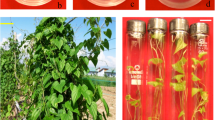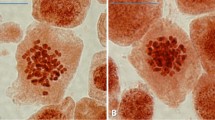Abstract
The present study aimed at exploring the fidelity of coconut (Cocos nucifera L.) plants recovered from cryopreservation. Zygotic embryos from various different cultivars were cryopreserved following four successive steps, namely: rapid dehydration, rapid freezing, rapid thawing and in vitro recovery followed by acclimatization. At the end of the acclimatization period, the seedlings were compared to counterparts of the same age, which were produced from non-cryopreserved embryos. Both series were submitted to morphological, cytological and molecular comparisons. No significant differences in terms of growth rates could be measured. In addition, no morphological variation could be detected through the measurement of shoot elongation rates, production of opened leaves, and the number and total length of primary roots. Karyotype analysis revealed the same chromosome number (2n = 32) in all studied cultivars independently of cryopreservation. No significant differences could be observed between control and cryopreserved material concerning the type of chromosomes, the length of the long and short arms, the arm length ratio and the centromeric index. However, idiogram analysis did show a greater number of black banding on chromosomes isolated from cryopreserved material. Genetic and epigenetic fidelity was assessed through microsatellite (SSR) analysis and global DNA methylation rates; no significant differences would be observed between genomic DNAs isolated from seedlings originating from cryopreserved embryos and respective controls. In conclusion, our results suggest that the method of cryopreservation under study did not induce gross morphological, genetic or epigenetic changes, thus suggesting that it is an appropriate method to efficiently preserve coconut germplasm.







Similar content being viewed by others
Abbreviations
- NYD:
-
Nias Yellow Dwarf
- NGD:
-
Nias Green Dwarf
- SOD:
-
Sagerat Orange Dwarf
- MYD:
-
Malayan Yellow Dwarf
- TKT:
-
Takome Tall
- WAT:
-
West African Tall
- COGENT:
-
Coconut genetic resources network
- GMR:
-
Global DNA methylation rate
References
Abraham A, Mathew PM (1963) Cytology of coconut endosperm. Ann Bot 27:505–513
Ahuja S, Mandal BB, Dixit S, Srivastava PS (2002) Molecular, phenotypic and biosynthetic stability in Dioscorea floribunda plants derived from cryopreserved shoot tips. Plant Sci 163:971–977
Apisitwanich S, Shishido R, Akiyama Y, Fukui K (2001) Quantitative chromosome map of representative indica rice. Euphytica 118:113–118
Assy-Bah B, Engelmann F (1992) Cryopreservation of mature embryos of coconut (Cocos nucifera L.) and subsequent regeneration of plantlets. Cryo Lett 13:117–126
Bajaj YPS (1984) Induction of growth in frozen embryos of coconut and ovules of citrus. Curr Sci 53:1215–1216
Bauchan GR, Campbell TA (1994) Use of an image analysis system to karyotype diploid alfalfa (Medicago sativa L.). J Hered 85:18–22
Baudouin L, Lebrun P, Konan JL, Ritter E, Berger A, Billotte N (2006) QTL analysis of fruit components in the progeny of a Rennell Island Tall coconut (Cocos nucifera L.) individual. Theor Appl Genet 112:258–268
Berjak P, Pammenter NW (2004) Biotechnology aspects of non-orthodox seeds: an African perspective. S Afr J Bot 70:102–108
Channuntapipat C, Sedgley M, Collins G (2003) Changes in methylation and structure of DNA from almond tissues during in vitro culture and cryopreservation. J Am Soc Hortic Sci 128:890–897
Chin HF, Krishnapillay B, Hor YL (1989) A note on the cryopreservation of embryos from young coconut (Cocos nucifera var MAWA). Pertanika 12:183–186
Engelmann F (2004) Plant cryopreservation: progress and prospects. In Vit Cell Dev Biol Plant 40:427–433
Fukui K (1996) Plant chromosome at mitosis. In: Fukui K, Nakayama S (eds) Plant chromosomes: laboratory methods. CRC Press, Boca Raton, pp 1–17
Fukui K (2005) Recent development of image analysis methods in plant chromosome research. Cytogenet Genome Res 109:83–89
Gerlach WL (1977) N-banding karyotypes of wheat species. Chromosoma 62:49–56
Hao YJ, Liu QL, Deng XX (2001) Effect of cryopreservation on apple genetic resources at morphological, chromosomal and molecular levels. Cryobiology 43:46–53
Hao YJ, You CX, Deng XX (2002) Analysis of ploidy and the patterns of amplified fragment length polymorphism and methylation sensitive amplified polymorphism in strawberry plants recovered from cryopreservation. Cryo Lett 23:37–46
Harding K (2004) Genetic integrity of cryopreserved plant cells: a review. Cryo Lett 25:3–22
Harding K, Benson EE (2001) The use of microsatellite analysis in Solanum tuberosum L. in vitro plantlets derived from cryopreserved germplasm. Cryo Lett 22:199–208
Harding K, Staines H (2001) Biometric analysis of phenotypic characters of potato shoot-tips recovered from tissue culture, dimethyl sulphoxide treatment and cryopreservation. Cryo Lett 22:255–262
Harding K, Marzalina M, Khishnapillay B, Zaimah NAN, Normah MN, Benson EE (2000) Molecular stability assessments of trees regenerated from cryopreserved mahogany (Swietenia macrophyla) seed germplasm using non-radioactive technique to examine the chromatin structure and DNA methylation status of the ribosomal RNA genes. J Trop For Sci 12:149–163
Helliot B, Panis B, Poumay Y, Swennen R, Leproivre P, Frison E (2002) Cryopreservation for elimination of cucumber mosaic and banana streak viruses from banana (Musa spp.). Plant Cell Rep 20:1117–1122
Hoisington D (1992) Laboratory protocols: CIMMYT applied molecular genetics laboratory. CIMMYT, Mexico
Holmquist GP (1989) Evolution of chromosome bands: molecular ecology of noncoding DNA. J Mol Evol 28:469–486
Hornung R, Domas R, Lynch PT (2001) Cryopreservation of plumular explants of coconut (Cocos nucifera L.) to support programmes for mass clonal propagation through somatic embryogenesis. Cryo Lett 22:211–220
Issolah R, Benhizia H, Khalfallah N (2006) Karyotype variation within some natural populations of sulla (Hedysarum coronarium L., Fabaceae) in Algeria. Genet Resour Crop Evol 53:1653–1664
Jaligot E, Rival A, Beule T, Dussert S, Verdeil JL (2000) Somaclonal variation in oil palm (Elaeis guineensis Jacq.): the DNA methylation hypothesis. Plant Cell Rep 19:684–690
Johnston JW, Benson EE, Harding K (2009) Cryopreservation induces temporal DNA methylation epigenetic changes and differential transcriptional activity in Ribes germplasm. Plant Physiol Biochem 47:123–131
Kaeppler SM, Phillips RL (1993) Tissue culture-induced DNA methylation variation in maize. Proc Natl Acad Sci USA 90:8773–8776
Kato S, Ohmido N, Fukui K (2004) CHIASIII. http://www2.kobe-u.ac.jp/~ohmido/cl/chiasIII/. Accessed 1 Nov 2006
Lebrun P, Berger A, Hodgkin T, Baudouin L (2005) Biochemical and molecular methods for characterizing coconut diversity. In: Batugal P, Ramanatha Rao V, Oliver J (eds) Coconut genetic resources. International Plant Genetic Resources Institute, Regional Office for Asia, the Pacific and Oceania (IPGRI-APO), Serdang, Selangor DE, Malaysia, pp 225–245
Levan A, Fredga K, Sandberg AA (1964) Nomenclature for centromeric position on chromosomes. Hereditas 52:201–220
Lukens LN, Zhan S (2007) The plant genome’s methylation status and response to stress: implication for plant improvement. Curr Opin Plant Biol 10:317–322
Marasek A, Mizuochi H, Okazaki K (2006) The origin of Darwin hybrid tulips analyzed by flow cytometry, karyotype analyses and genomic in situ hybridization. Euphytica 151:179–190
Martinez-Montero ME, Ojeda E, Espinosa AS M, Castillo R, Gonzalez-Arnao MT, Engelmann F, Lorenzo JC (2002) Field performance of sugarcane (Saccharum sp.) plants derived from cryopreserved calluses. Cryo Lett 23:21–26
Messeguer R, Ganal MW, Steffens JC, Tanksley SD (1991) Characterization of the level, target sites and inheritance of cytosine methylation in tomato nuclear DNA. Plant Mol Biol 16:753–770
Moukadiri O, Deming J, O’Connor JE, Carnejo MJ (1999) Phenotypic characterization of the progenies of rice plants derived from cryopreserved calli. Plant Cell Rep 18:625–632
N’Nan O, Hocker V, Verdeil JL, Konan JL, Balo K, Mondeil F, Malaurie B (2008) Cryopreservation by encapsulation-dehydration of plumules of coconut (Cocos nucifera L.). Cryo Lett 29:339–350
Nambiar MC, Swaminathan MS (1960) Chromosome morphology, microsporogenesis and pollen fertility in some varieties of coconut. Indian J Genet Plant Breed 20:200–211
Ninan CA, Raveendranath TG (1975) A study of karyotype of spicata and typica varieties of coconut and its bearing on the breeding behaviour of spicata palms. New Bot 2:81–87
Ohmido N, Sato S, Tabata S, Fukui K (2007) Chromosome maps of legumes. Chromosome Res 15:97–103
Olivares-Fuster O, Asins MJ, Duran-Vila N, Navarro L (2000) Cryopreserved callus, a source of protoplasts for Citrus improvement. J Hortic Sci Biotech 75:635–640
Phillips RL, Kaeppler SM, Olhoft P (1994) Genetic instability of plant tissue culture: breakdown of normal controls. Proc Natl Acad Sci USA 91:5222–5226
Rani V, Raina SN (2000) Genetic fidelity of organized meristem-derived micropropagation plants: a critical reappraisal. In Vitro Cell Dev Biol Plant 36:319–330
Rasband WS (2006) ImageJ. http://rsb.info.nih.gov/ij/. Accessed 2 Nov 2006
Richards CM, Reilley A, Touchell DH, Antolin MF, Walters C (2004) Microsatellite primers for Texas wild rice (Zizania texana), and a preliminary test of the impact of cryogenic storage on allele frequency at these loci. Conserv Genet 5:853–859
Rillo EP (2004) Importing and growing embryos for the coconut genebank. In: Ikin R, Batugal P (eds) Germplasm health management for COGENT’s multi-site international coconut genebank. Int Plant Genetic Resources Institute-Regional Office for Asia, the Pacific and Oceania (IPGRI-APO), Serdang, Selangor DE, Malaysia, pp 62–68
Ryynanen LA, Aronen T (2005) Genome fidelity during short- and long-term tissue culture and differentially cryostored meristems of silver birch (Betula pendula). Plant Cell Tissue Organ Cult 83:21–32
Shan F, Yan G, Plummer JA (2003) Karyotype evolution in the genus Boronia (Rutaceae). Bot J Linn Soc 142:309–320
Urbanova M, Cellarova E, Kimakova K (2002) Chromosome number stability and mitotic activity of cryopreserved Hypericum perforatum L meristem. Plant Cell Rep 20:1082–1086
Urbanova M, Kosuth J, Cellarova E (2006) Genetic and biochemical analysis of Hypericum perforatum L. plants regenerated after cryopreservation. Plant Cell Rep 25:140–147
Wei YM, Hou Y, Yan ZH, Wu W, Zhang ZQ, Liu DC, Zheng YL (2005) Microsatellite DNA polymorphism divergence in Chinese wheat (Triticum aestivum L.) landraces highly resistant to Fusarium head blight. J Appl Genet 2005:3–9
Wilkinson T, Wetten A, Prychid C, Fay MF (2003) Suitability of cryopreservation for the long-term storage of rare and endangered plant species: a case history for Cosmos atrosanguineus. Ann Bot 91:65–74
Acknowledgments
The authors gratefully thank the Australian Agency for International Development (AusAID), the Australian Centre for International Agricultural Research (ACIAR), the Graduate School Research Travel Grants (GSRTG) scheme at the University of Queensland and the French CIRAD-Desi/DRS Projects for financial support. We are grateful to Dr. Hengky Novarianto and his staff at the Indonesian Coconut and Other Palm Research Institute (ICOPRI), Manado, Indonesia for preparation of plant material. The authors thank Mr. Thierry Beule, Dr. Estelle Jaligot and Mrs. Sylvie Doulbeau, IRD, Montpellier, France for their kind help in DNA methylation analysis and Ms. Angelique Berger, CIRAD, Montpellier, France for her help in microsatellite analysis.
Author information
Authors and Affiliations
Corresponding author
Rights and permissions
About this article
Cite this article
Sisunandar, Rival, A., Turquay, P. et al. Cryopreservation of coconut (Cocos nucifera L.) zygotic embryos does not induce morphological, cytological or molecular changes in recovered seedlings. Planta 232, 435–447 (2010). https://doi.org/10.1007/s00425-010-1186-x
Received:
Accepted:
Published:
Issue Date:
DOI: https://doi.org/10.1007/s00425-010-1186-x




